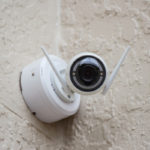Campus Surveillance & Security Measures
As students head back to school, it is important to consider campus security and how we can keep our children safe. Surveillance camera systems on campus are important assets in helping to make schools safer – here’s why.
Deter Crime
The mere presence of security cameras is known to reduce criminal activity. Bottom line, surveillance poses a risk of getting caught and criminals simply don’t want that.
Prevent Vandalism & Theft
Because schools and campuses have predictable off hours, it is easy for vandals and thieves to target them. However, strategically placed security cameras and alarm systems can help to prevent this type of activity.
Eliminate Unauthorized Intruders
By monitoring and evaluating surveillance footage, you can more easily identify persons that do not belong in the area.
Monitor Entrances, Exits & Corridors
Since foot traffic is high during the school day, most entrances and exits must remain unlocked, making them vulnerable to intruders. Keeping an eye on these, as well as hallways and corridors, will help identify who is or has been on school property as well as what they did or are doing there.
Visitor Monitoring
Any visitor can pose a potential threat, and surveillance camera footage can keep track of that. Having eyes on the situation allows for quick response if any misbehavior or misconduct occurs.
We carry a wide variety of security cameras and surveillance packages for your home, school, or business. Visit us online at SecurityCamExpert.com to browse our stock, or call 888-203-6294 to schedule a site survey or request a free quote. You can also connect with us on Facebook, Twitter, LinkedIn, and Pinterest.
Security Cameras: Analog Versus IP
Whether you are looking to upgrade your analog security cameras, or you are shopping for a new security system, it’s important to know the differences between analog and IP cameras to determine which type will best suit your needs. There are advantages and disadvantages to both types of cameras – be sure to review these before making a final decision.
Advantages of Analog Cameras
- Cost: If you have an existing analog system, it is obviously cheaper to stick with it. If you are on the market for security system, analog cameras are often significantly cheaper, and if you need to add more cameras, analog is likely the more cost-effective option.
- Availability: You will have an easier time finding vendors and installers for analog system since they have been around for years and are fairly simple to install.
- Simplicity: Speaking of, analog cameras offer an ease of use that make them very user friendly. The cameras send recordings to a DVR (digital video recorder), which then converts the analog to digital and stores it. And managing and using DVRs is simple as well.
- Technology: The technology used with analog has greatly improved over the years. High definition (HD) analog offers improved picture quality and resolution.
Disadvantages Of Analog Cameras
- Frame Rate & Image Quality: Analog cameras have a lower frame rate than IP cameras, so if you’re monitoring an area with lots of motion or need extreme detail, they are not ideal. Analog images are not as sharp and may appear grainy or blurry, and you cannot digitally zoom as you can with IP cameras. However, depending on the type of surveillance you need in a given area, high frame rate may not be a crucial factor.
- Less Coverage: Covering a certain amount of area may require more analog cameras than it would with IP cameras.
- More Cables: Analog cameras require a power cable and a DVR cable, whereas IP cameras only require one cable.
- No Encryption: The lack of encryption leaves you at risk for a hacker to potentially access your information or replace your signal with an outside one.
Advantages of IP Cameras
- Multiple Sensors: IP cameras can cover a larger area because they can contain as many as three to four cameras in one. All of these become one signal and are transferred through one cable to your system.
- Cost: Early on, the price difference between analog and IP cameras were drastic. Luckily, the prices have gone down and many IP cameras boast cost-effective prices. Also, because fewer IP cameras are required to the do same job as multiple analog cameras, your investment can be more beneficial.
- Installation: IP cameras only require one cable per camera and allow you to focus and zoom remotely. So long as your camera is installed at the right angle, you can easily control and manage your video feed from your workstation.
- Resolution: IP cameras have better image quality than analog cameras, and are available with different resolutions and aspect ratios to suit your needs.
- Intelligence & Analytics: IP cameras offer the ability to compress and store videos as well as provide a variety of different analytics. Some types of analytics you can program include motion or smoke detection, people counting, color tracking, and more.
- Security: IP video is encrypted and authenticated to ensure secure transmission.
- Equipment: IP camera systems require less equipment (analog requires more cables as well as an encoder and decoder).
- Open Platform: IP cameras are essentially universal and make it easy to add new features and functions to your system.
Disadvantages Of IP Cameras
- Cost Of Initial Set-Up: Upfront pricing may be more initially, but it can pay off in the long run. Once set up, it is must easier to tailor and scale your system as needed in the future.
- Storage: Since IP cameras produce higher resolution images, they generate larger files which require more storage space.
- Learning Curve: There is a user interface that end users may need to get accustomed to. While it is mostly intuitive, there is a certain level of technicality that needs to be learned.
From Analog To IP
If you are making the switch from analog to IP, here are some helpful tips.
- Bring in an independent consultant. You may have unrealistic expectations for your cameras that do not fit their capabilities, and an impartial party can help you see that.
- Replace as you can. If budget is not an issue, switching out your entire analog system for IP cameras at once is feasible. However, many of us have limited budgets, so replacing a few cameras at a time may be more practical. In doing so, you are creating a hybrid system, which supports both analog and IP cameras. Start by replacing the most important cameras to IP and create a plan for switching the rest of the analog cameras as they run their course.
- Find an installer/vendor that specializes in IP systems. It is beneficial to work with someone who understands the technology and networking of the system and is capable of installing your system properly and advising you on how to use it.
- Discuss what you really need. Just because IP cameras provide a wide range of capabilities does not mean you necessarily need all of them. Determine what you want your cameras to accomplish, what you really need, and how your budget can help you carry out your vision.
- Revisit your security plan. When making the switch, it is the ideal time for you to revise your security plans and reevaluate your approach.
What other transition tips can you think of? Share with us on Facebook, Twitter, LinkedIn, and Pinterest.
If you need help choosing IP security cameras, or would like to request a site survey or free quote, please call us at 888-203-6294. You can also browse our stock of quality security cameras online at SecurityCamExpert.com.
What You Need To Know About Cloud Cameras
What are cloud cameras and why should you invest in them?
A cloud-based security camera, or cloud camera, is a security camera that is closely related to the IP camera. Both cloud and IP cameras connect to the internet, however, with cloud cameras, you need not assign IP addresses to each camera. Cloud cameras make it simple – all they need is a power cord and an Ethernet cable and you’re set. Cloud cameras will come with software or an app that enables streaming and remote camera management via smart device or computer.
On the upside, cloud cameras offer excellent benefits for users. First of all, these cameras are extremely easy to set up as they essentially plug-and-play. They are compact, affordable and accessible.
Cloud-based cameras also allow you to access your video feed virtually anytime from any place. While IP cameras can also provide this benefit, they require a bit more extensive set up to ensure proper performance and security.
In addition, cloud cameras boast automatic updates, device software improvements, and security vulnerability patching. Maintaining any additional hardware and software is no longer a worry.
With these advantages come some disadvantages. Cloud cameras come with monthly fees and limited functionality depending on how much you are willing to pay. And your provider may raise prices at any time, thus you must pay the higher price or purchase a different camera.
Privacy concerns and security risks are another factor, as your video feed is available on an external server. Also, because your cloud camera will be constantly sending data over the internet, it can slow down connection for other internet activities. For those in areas with slow service or data caps, cloud cameras may not be a feasible option.
The important thing to remember is that there are numerous security cameras with different features on the market. You should evaluate your needs and research different types of cameras to determine which type is right for you. If you need some help or have any questions, please feel free to contact us at 888-203-6294. You can also browse our selection of top quality security cameras at cost-effective prices online at SecurityCamExpert.com. Connect with us on Facebook, Twitter, LinkedIn, and Pinterest.
Back To School Safety
As summer vacation draws to a close, back to school season is here again. If your children have started school, or will start school shortly, be sure to review and apply these school safety guidelines from the National Safety Council.
Transportation Safety
Proper safety precautions are crucial for the trip to and from school. You want to ensure that your kids arrive at school and return home in one piece.
• Walkers
Review family’s walking safety rules and practice walking to school with your child.
• Walk on the sidewalk, if one is available. When walking on a street with no sidewalk, walk facing the traffic.
• Before you cross the street, stop and look left, right, and left again to see if cars are coming. Proceed if the roadway is clear.
• Make eye contact with drivers before crossing and always cross streets at crosswalks or intersections.
• Stay alert and avoid distracted walking.
• Bike Riders
Teach your child the rules of the road and practice riding the bike route to school with your child.
• Ride bikes on the right side of the road, with traffic, and in a single file.
• Come to a complete stop before crossing the street and, when clear, walk bikes across the street.
• Stay alert and avoid distracted riding.
• Make sure your child always wears a properly fitted helmet and bright clothing.
• Bus Riders
Teach your children school bus safety rules and practice with them.
• Go to the bus stop with your child to teach them the proper way to get on and off the bus.
• Teach your children to stand 6 feet (or three giant steps) away from the curb.
• If your child must cross the street in front of the bus, teach him or her to walk on the side of the road until they are 10 feet ahead of the bus. Your child and the bus driver should always be able to see each other.
• Driving Your Child To School
Stay alert and avoid distracted driving.
• Obey school zone speed limits and follow your school’s drop-off procedure.
• Make eye contact with children who are crossing the street.
• Never pass a bus loading or unloading children.
• The area 10 feet around a school bus is the most dangerous for children – stop far enough back to allow them to safely enter and exit the bus.
• Teen Drivers
Car crashes are the leading cause of death for teens. Fortunately, there are ways to decrease this risk.
• Crashes can be attributed to teens’ inexperience. Practice with new drivers every week, before and after they get their license.
• Set a good example by driving the way you want your teen to drive.
• Set up an agreement between you and your teen driver that helps define rules and expectations of both parties. As time goes on, responsibilities and restrictions can be adjusted accordingly. This is sometimes referred to as a Parent-Teen Agreement or New Driver Deal.
School Safety
Many School-related injuries are completely preventable. Here are some ways to ensure your child’s safety at school.
• Backpacks
Your child’s backpack should have ergonomically designed features to enhance safety and comfort.
• Ask your children to use both straps when wearing their backpack to even distribute the weight on their shoulders.
• Don’t overstuff a backpack – Backpacks should weigh no more than 5% to 10% of your child’s body weight.
• Rolling backpacks should be used cautiously since they can create a trip hazard in crossed school hallways.
Playgrounds & Sports
• To reduce strangulation hazards on playgrounds, keep necklaces and jackets with drawstrings at home.
• A few bumps and bruises can be expected when your child plays sports, but head injuries should never be ignored.
Share your back to school safety tips with us on Facebook, Twitter, LinkedIn, and Pinterest.
Shop our stock of quality CCTV security cameras and surveillance equipment online at SecurityCamExpert.com. To learn more about our products and services, or to request a free quote or site survey, please call 888-203-6294.



